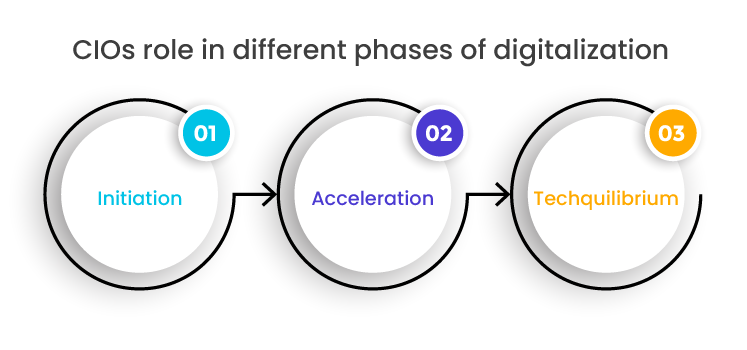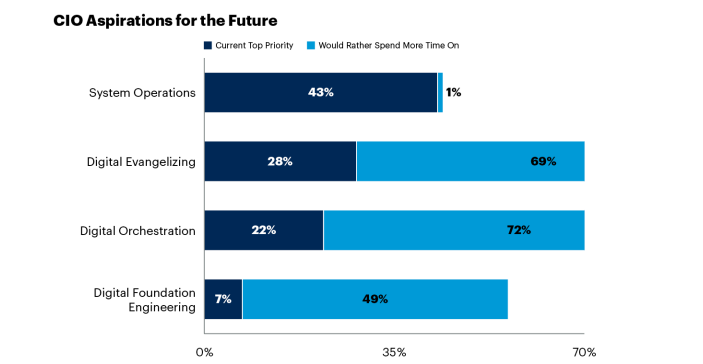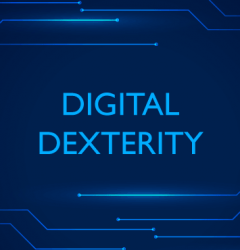
The growing usage of data and technology throughout the organization and the emergence of technology producers outside of IT have prompted C-suite executives to define executive-level digitalization tasks and optimally allocate them across all CxOs. Many, if not all, CxOs will take on responsibility for their domain’s technological resources, necessitating the evolution of CIO roles.
As per Gartner, the importance and impact of CIOs on corporate performance have only grown. As a result of rising digitalization, CIOs today have more opportunities to contribute beyond the fundamentals of designing and managing technology. They can actively contribute as chief digital officers by spearheading key digital initiatives, increasing their involvement in strategy formation, and encouraging other executives to contribute to the digital agenda.
The changing dynamics of technology leadership
A majority of CIOs are accelerating their digital business initiatives and seeing their roles expand as a result of this greater focus on digital. They are gradually obtaining their own digital resources and expertise to run the highly digitalized capabilities they are responsible for. There is a steady rise in the number of non-IT leaders who have a hand in designing their enterprises’ digital futures. For example, business users are leveraging no-code platforms to build priority-specific applications.
Information and technology are becoming more and more important to business leaders at all levels. These leaders are taking the lead in establishing and carrying out their technological priorities. According to Gartner, 78 percent of CIOs believe that their business leaders and teams are engaging with digital projects far more than before. As companies strive to realize their digital objectives, every CxO will inevitably be expected to take on technical tasks and accountabilities.
The three primary factors driving technology leadership evolution are:
- Increased levels of non-IT employees producing technology to improve business capability performance
- Growing digital dexterity of CxOs and critical non-IT leaders
- Need for a new enterprise technology delivery model to support high digitalization
CIOs’ role in different phases of digitalization
The journey toward the optimal enterprise technology delivery model can be defined by three stages, each of which requires an evolution of technology leadership – a) Initiation, b) Acceleration, c) Techquilibrium

The CIO and CxOs shift their roles and responsibilities at each stage of the digital transformation process. They are able to dynamically accept, relinquish or assign diverse digital responsibilities in order to develop and sustain the new technology paradigm. CIOs generally perform the following actions at any given point in their digital journey:
System operations – Traditional IT administration tasks that focus on assuring the stability of enterprise systems for end-users.
Digital evangelizing – Promoting the value of digital dexterity among CxOs who are accountable for technology by defining enterprise digital ambition and strategies, leading select digital initiatives, establishing programs to advance enterprise-wide digital dexterity, and promoting work with the C-suite to define and distribute new digital business executive responsibilities.
Digital orchestration — Developing new organizational structures based on cross-functional collaboration, encouraging creative working techniques like agile, product management, or design thinking, and managing the growing interdependencies of business-led solutions in a way that ensures their success.
Digital foundation — Encouraging IT and non-IT technology providers to build safe, integrated, and scalable systems. Collaborating with CxOs for designing and developing the next generation of cross-cutting technology platforms for enterprise IT delivery. Standardizing common technological production processes like testing and hosting can also enable self-service capabilities.

Phase 1: Initiation
When there are few digitally savvy leaders, the CIO along with the digital strategist or chief digital officer) should spearhead the efforts to enhance people, processes, and technology for digital success. They should conduct technology trials to address current business concerns rather than identifying ways in which digital might revolutionize how an organization defines and delivers value. For example, the chief financial officer (CFO) may wish to leverage robotic process automation (RPA) to cut expenses in the finance function, while the chief human resources officer (CHRO) may choose to leverage cloud computing to host talent management platforms.
Often there is inertia within the company leadership team when it comes to digital transformation initiatives. Therefore, to establish an effective leadership model, CIOs should spend significant time developing partnerships across the C-suite to develop enterprise digital dexterity. Progressive CIOs frequently develop an enterprise digital business narrative and incorporate digital into business strategy in order to lay the groundwork for such collaborations. Additionally, they recognize leaders who have the sharp acumen for digital business and broaden their perspectives on digital.
Also Read: Why CIOs Can’t Afford Slow Transformation: No-Code Enterprise Agility as the New Digital Imperative
CIOs must continue to excel at completing system operations-related tasks. Maintaining the credibility necessary for CIOs to succeed as digital advocate requires ensuring solid enterprise systems and bringing in the correct IT capabilities to exhibit the art of the possible with digital.
However, in some circumstances, the CIO may not be viewed as the organization’s primary strategist or the CEO may believe that a fresh viewpoint is necessary to highlight the organization’s digital business potential. In certain instances, CIOs will need to develop strong partnerships with either a chief strategy officer or a chief digital officer, who will have increased ownership or influence over shaping and executing the enterprise’s digital agenda. CIOs should collaborate with those executives to ensure they have the resources and knowledge necessary to advance their digital agendas. If CIOs do not take these steps, they risk being perceived as a hindrance rather than the propagator of digital business change.
Also read: Digital Leadership in a New Era and How Workplace Culture Matters More Than Ever
Phase 2: Acceleration
CIOs with the ambition and capability to establish a digital business and work in a digital environment should direct their technological resources toward capitalizing on digital business prospects, resulting in the formalization of digital leadership in various pockets of the organization. Following are three types of digital leadership that can emerge focusing on product, channel, or operations, depending on where the company has the highest digital business potential:
1. Product-centric leadership
Product-centric leadership focuses on the product or service’s digitalization. For instance, the organization may employ artificial intelligence to change product performance in response to a customer’s individual wants, or it may productize data obtained via sensors on physical objects.
In this model, key business leaders are typically heads of specialized business units (BUs) or product portfolios, the head of research and development, a chief digital officer, or even a chief data and analytics (D&A) officer. This strategy is more suited for information-intensive industries (such as financial services, reinsurance, and media), engineering and design-intensive industries (such as aerospace and agroscience), and technology-intensive industries (such as software).
2. Channel-centric leadership
Channel-centric leadership places a premium on leveraging information and technology to enhance the end-to-end customer experience and minimize customer effort. The chief marketing officer (CMO), the head of sales, the head of customer service, the head of customer experience (CX), or the chief digital officer are typically the primary business leaders in this approach. Organizations that market and sell physical products to consumers, such as those in food and beverage, retail, and pharmaceuticals, as well as governments and other public institutions, will typically take this strategy.
3. Operations-centric leadership
Operations-centric leadership focuses on transforming the organization’s operations in order to lower the cost of products sold or improve the organization’s quality, agility, or speed to market. The company executives who assume digital duties in this approach are typically the chief supply chain officer, head of operations, chief operating officer, chief human resources officer, chief financial officer, or chief data officer. Firms with major physical assets or complex supply chains, such as those in heavy manufacturing, mining, or logistics, should choose this approach.
There is an uneven amount of digital dexterity among acceleration leaders. This demands CIOs to continue conducting digital evangelism and system operations tasks while also increasingly leveraging their technical skills and cross-functional ability. By automating service delivery, outsourcing non-competitive IT capabilities, and delegating traditional IT roles throughout the IT organization, CIOs may spend less time on system operations and more on orchestration and foundation engineering.

Phase 3: Techquilibrium
Using a techquilibrium digital leadership paradigm, organizations get the best of both old and new. Every CEO becomes a digital leader, which implies that digital leadership gets ingrained in all leadership roles throughout the organization. It takes time for some firms to adapt to such a leadership approach. When it comes to defining and delivering value for high-tech enterprises, this strategy is more widespread nowadays. Among other things, R&D can drive the development of new digital products and services, while marketing and sales can spearhead the transformation of customer interaction, and CHROs can take care of digital workplace projects.
Even if it takes years for their firms to get there, many CIOs across multiple industries believe that embedded digital leadership is the most likely destination. Having said that, a widely dispersed approach comes with a slew of drawbacks. Security and compliance, customer experience variation, data abuse, and segregated knowledge are just some of the issues that might arise. CIOs should commit more time to digital orchestration in order to make this leadership paradigm succeed. Actions may include:
- Inspiring innovative ways of doing business and promoting the sharing of ideas
- Establishing an incubator for digital engineering talent in the workplace
- In order to ensure that the enterprise’s procedures are uniform, structurally sound, and secure,
In addition, CIOs can spend more time developing digital foundations because of the expanding number of technology producers and fusion teams in many business areas. CIOs can use their skills as technology experts to manage cross-cutting platforms and integration capabilities so that distributed digital initiatives may be developed and integrated more quickly.
While the majority of CIOs understand the importance of redistributing digital duties and adapting their roles accordingly, there is a lot to be done. This is echoed in Gartner’s CIO polling results, which revealed that 43% of CIOs prioritize system operations tasks, and only 28%, 22%, and 7% of CIOs, respectively, prioritize digital evangelization, digital orchestration, and digital foundation engineering efforts. At the same time, CIOs are already planning to shift their focus in order to better fit with their organizations’ shifting needs. 69% percent of CIOs want to increase their time spent on digital evangelizing, while 72 percent and 49 percent of CIOs want to increase their time spent on digital orchestration and foundation engineering, respectively.
Also Read: Rapid App Development with Quixy
How Quixy Supports CIOs with Their Strategy
Quixy, a leading no-code low-code platform, helps CIOs overcome digital transformation challenges by:
Accelerating Innovation: Enabling rapid application development without deep coding expertise.
Enhancing Process Automation: Streamlining workflows and reducing manual inefficiencies.
Ensuring Compliance & Security: Offering robust governance controls and audit trails for regulatory compliance.
Supporting Scalability: Allowing businesses to adapt their workflows as they grow.
Promoting Sustainability: Enabling remote collaboration and reducing reliance on paper-based processes.
Conclusion
The digital business era will usher in a fundamentally new view of corporate IT leadership. New leadership models will emerge in response to an organization’s digital business prospects and the increasing presence of digitally savvy executives. CIOs’ key areas of concentration will need to shift in order to assist business executives in taking greater ownership of digital ideation and delivery responsibilities. While these leadership styles will gradually narrow the scope of CIOs’ responsibilities, their power and impact within their enterprises will remain unaffected. CIOs that spend more time organizing distributed technology activity and developing their firms’ business strategy through core technology will be the most effective.
Login
Please login to comment
0 Comments
Oldest
















